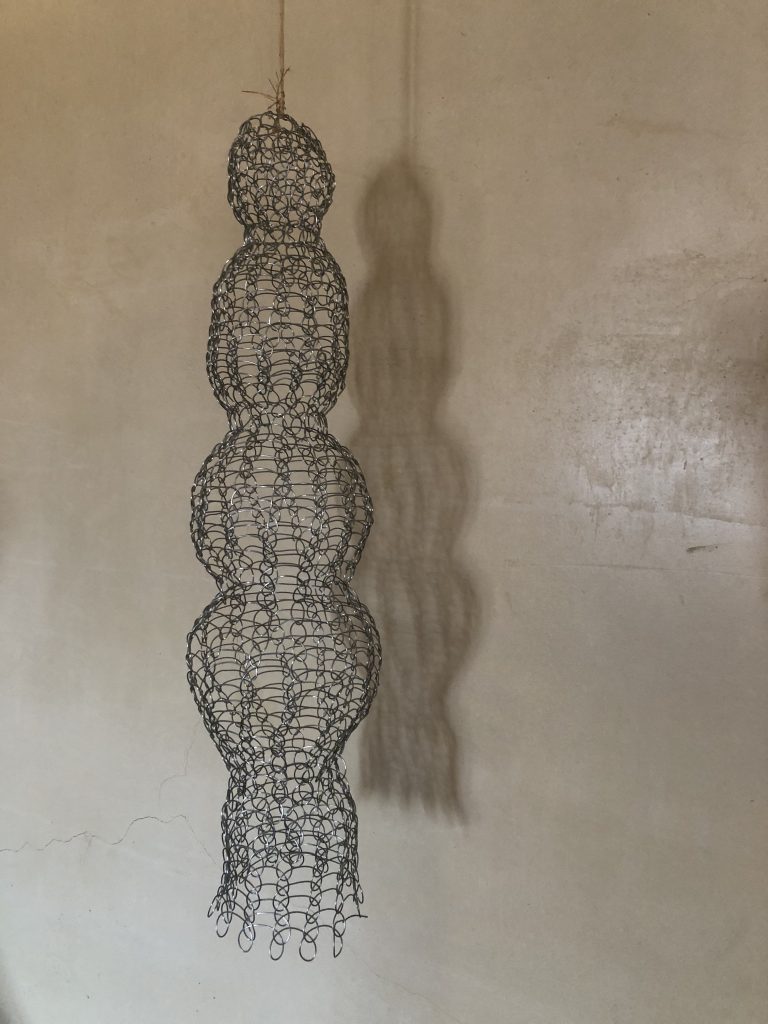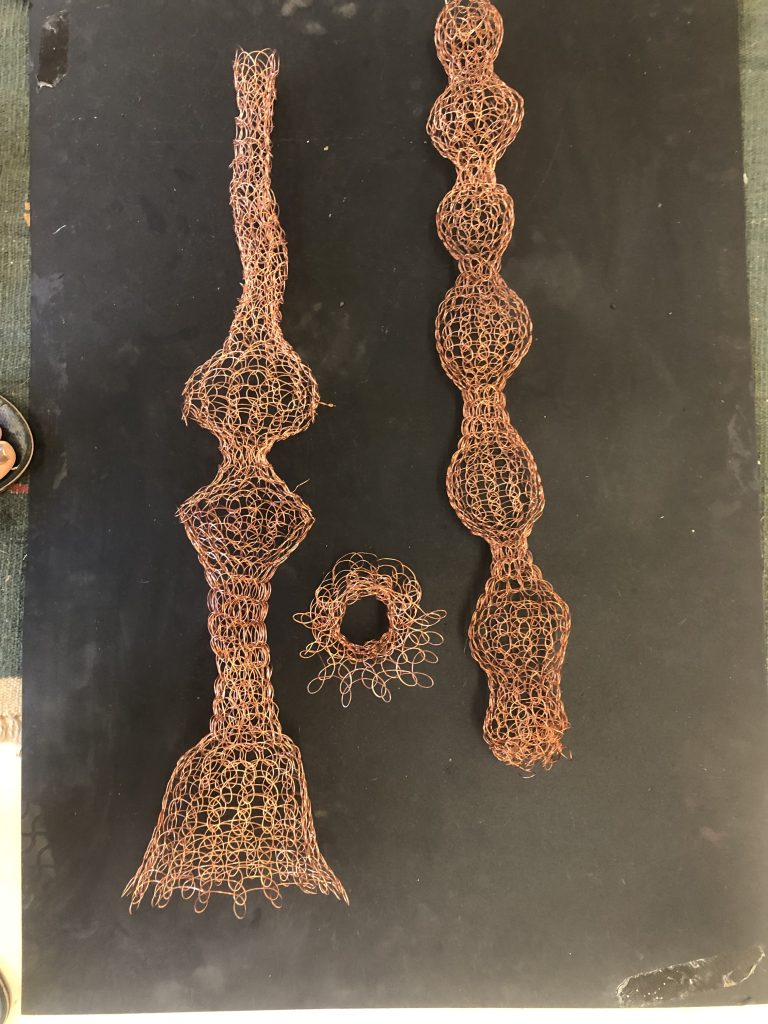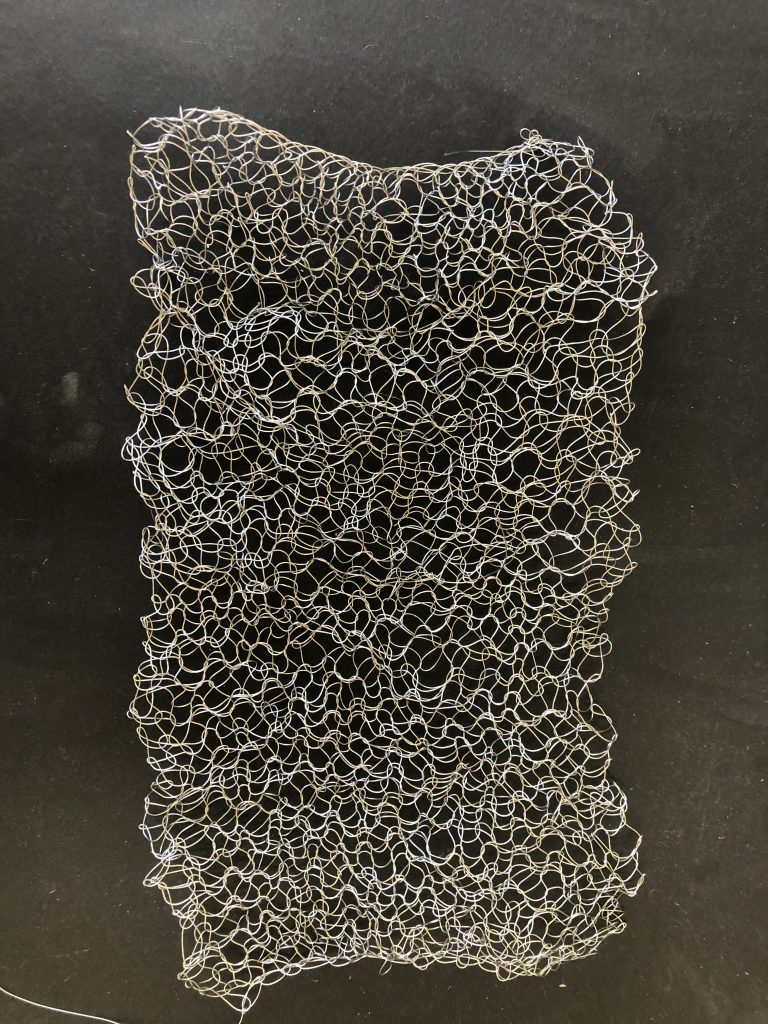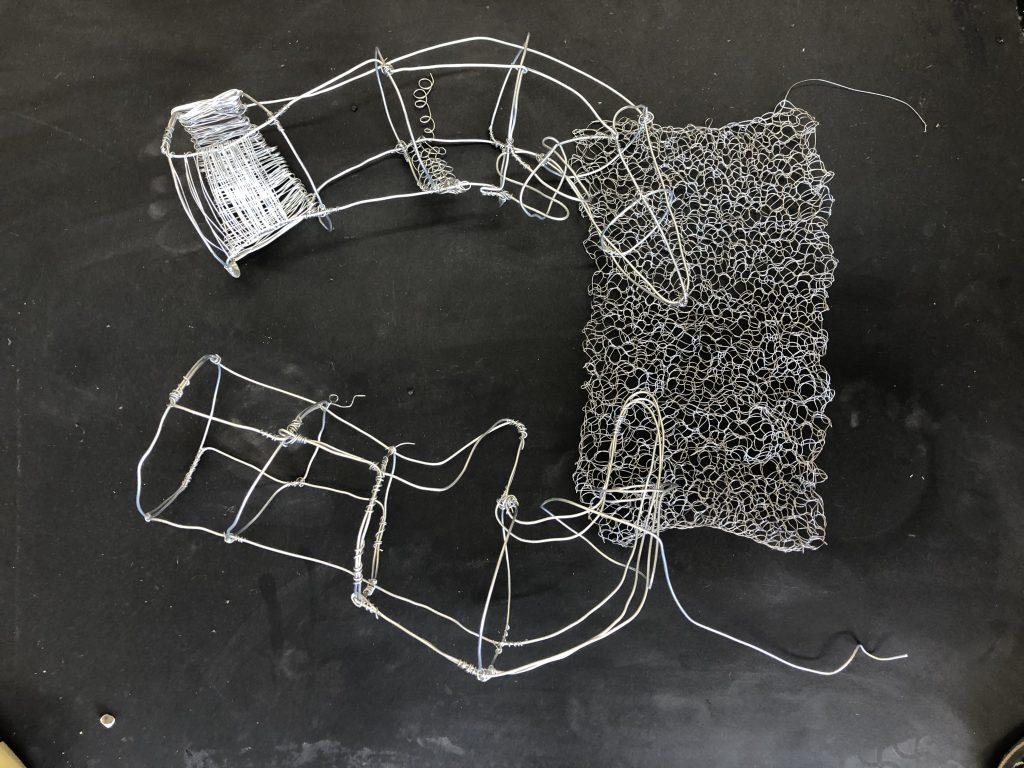BODY OF WORK
Key works I have made are three small objects with copper, a bigger one with wire and then works in progress.



Below is a collage of earlier work. I used this to look at how wire has been used as a way to contain in earlier work. The work also deals with inward thinking—personal content.

Below is a knitted wire work

I have made two hand gloves to use for a performance. The work was started at a workshop with a wire artist and I continued to make another one. I now have to cover the work. The works were made with a single wire – I had to bend and manipulate the form without cutting the wire. This work reminds me of project 3 ( Keep doing it, Exercise 4 ) as it was created with one rule: not to cut the wire and keep it straight while making.

DRAFT PRACTICE PLAN
Statement
1 Artist Statement:
Karen Stander’s work explores interconnectedness with the non-human world through nest-making. Inspired by nature’s tenderness and care, her pieces evoke emotions and thoughts on the fragility and beauty of life. By delving into the tactile nature of materials and the rhythmic process of creation, Stander invites viewers to contemplate their place within the ecosystem and the shared vulnerability of all beings. Through her art, she seeks to create spaces of introspection and connection, encouraging a deeper understanding of our relationship with the natural world.
2 Media, Materials, Processes, and Techniques
Media and Materials:
- 3D Objects: Wire, raffia, paper, fungi, clay
- Drawing/Painting: Charcoal, oil paints
- Printmaking: Interested in exploring Monoprint and chine colle
Processes and Techniques:
- Material Exploration: Focus on the materiality of chosen materials
- Upscaling/Minimizing: Create a series of works exploring kinship between objects
- Revisiting and Reusing: Return to earlier works, consider alterations and reuse
- Printing Experiments: Incorporate chine colle with forms and shapes
- Upscaling Technique: Using wire and tree/plant branches for structural elements
3. Research Concerns Driving a Practice-led Research
Themes:
- Nest as Metaphor: Symbolizing safety, protection, loss, and connectedness
- Home and Memories: Reflecting on memories, safety, and intimate spaces
- Human and Nature Connection: Exploring fragility, transience, and harmony. One can also look at the woven form, metamorphosis, growth, renewal and rebirth.
- Building a Massive Nest: Focus on creating a life-sized nest in a safe space
- Collaborate with a local artist to explore a safe space/vulnerability/: Solo Studio’s August 2024
Inspirations:
- Artists Influencing Practice:
-
- Louise Bourgeois: Emotional context and transferring energy into art
- Ruth Asawa: Technique and materials
- Eva Hesse: Close connection to the act of making and the artist’s presence
- Fiona Campbell: Her mixed media sculptures are inspirational, and her work is about drawing in space- the way she uses her materials.
- Anna Medieta: Use of own body ideas around site specificity. Merging the personal with the site
- Book Reference: “Exploring Art for Perspective Transformation” by Alexis Kokkos
4. Means and Methods of Reflection and Evaluation
- Writing and Sharing: Reflect on outcomes and process through writing
- Peer Engagement: Share work with fellow students, friends, and artists for feedback
- Self-Reflection: Regularly evaluate the learning and making process
5. Processes and Means of Recording and Documentation
- Documentation Methods:
- Photographs: Documenting artworks at different stages
- Journaling: Recording thoughts, reflections, and inspirations
- Archive Creation: Synthesizing articles, photographs, video stills, and videos
- Artwork Portfolio: Curate a portfolio showcasing progress and finished pieces
- Artwork Installations: Document installations outside the studio, focusing on impermanence and human attachment
6. Exploration of Contemporary Wire Artists
- Artists for Research:
- Racso Jugarap
- Nils Udo
- Jacqueline Mallegni
- Michele Yi Martin
- Nettie Sumner
- Ralph Borland (Local)
- Celia Smith (Local, living overseas)
- Olafur Elliason
7. Timeline and Milestones
Skills Acquisition:
- Mechanization Skills:
- Learn to use tools and equipment for mechanizing processes, like wire looping. I now have a more giant wheel mechanism to use for this process and will add a mechanised process to assist with the looping
- Attend workshops or seek online tutorials for efficient wire-handling techniques.
- Printmaking Skills:
- Enrol in a printmaking course to develop skills in Monoprint and chine colle.
- Practice different printmaking techniques to incorporate into your art.
- Documentation and Archiving:
- Learn photography techniques for documenting artworks at various stages.
- Explore video recording/editing skills for creating process videos.
- Collaborative Skills:
- Enhance communication and collaboration skills for working with assistants or community members.
- Attend workshops or courses on teamwork and leadership.
Strengthening Connections and Networks:
- Local Art Communities:
- Attend local art events, exhibitions, and workshops to meet fellow artists.
- Join art associations or groups focused on social impact or feminist art.
- Online Platforms:
- Utilize social media platforms for sharing your work and connecting with a wider audience.
- Engage with online art communities, forums, and groups for discussions and networking.
- Artist Residencies or Workshops:
- Apply for artist residencies or workshops on feminist art, materiality, or ecological themes.
- Participate in residencies that offer opportunities for collaborative projects.
Art Collection Visits:
- Research and Plan Visits:
- Identify art collections or museums with works relevant to your themes (materiality, feminist art).
- Plan visits to view specific pieces or exhibitions that inspire your practice.
- Art Analysis and Reflection:
- Analyze artworks in the collection related to material transparency, fluidity of line, and interconnectedness.
- Reflect on how these artworks inform or challenge your artistic approach.
- Networking at Collections:
- Attend gallery talks, curator-led tours, or artist talks at the collections.
- Network with curators, artists, and fellow visitors to discuss shared interests.
Documentation of Work:
- Photography and Videography:
- Capture high-quality images of your artwork at different stages of creation.
- Create process videos showing the evolution of your pieces, techniques used, and insights.
- Artist Statement and Cataloging:
- Write detailed artist statements for each artwork, explaining concepts and inspirations.
- Maintain a cataloguing system for organizing and documenting your works, including dates, materials, and dimensions.
- Online Portfolio:
- Develop a professional online portfolio or website showcasing your artwork.
- Update the portfolio regularly with new pieces, descriptions, and exhibition history.
- Journaling and Reflection:
- Keep a journal or sketchbook for personal reflections on your artistic journey.
- Document thoughts, ideas, and challenges faced during the creative process.
Timeline and Milestones (Updated):
- Skills Acquisition and Workshops: Ongoing
- Attend mechanization workshops for wire handling.
- Enroll in printmaking courses to develop techniques.
- Practice photography and video skills for documentation.
- Networking and Community Engagement:
- Attend local art events and workshops to network.
- Join online art communities and engage in discussions.
- Apply for artist residencies or workshops for collaborative projects.
- Art Collection Visits and Analysis:
- Plan visits to relevant art collections for inspiration.
- Reflect on artworks related to material transparency and interconnectedness.
- Network at collection events, talks, and tours.
- Documentation and Archiving:
- Document artworks with high-quality photography and videos.
- Write detailed artist statements for each piece.
- Maintain an online portfolio with updated works and descriptions.
Conclusion:
Acquiring new mechanization, printmaking, and documentation skills will enhance my artistic practice and ability to convey my concepts effectively. Strengthening connections with local and online art communities will provide collaboration, feedback, and exposure opportunities. Visits to art collections will inspire and inform my work while documenting my process and artworks will ensure a comprehensive record of your artistic journey. These additions to the Practice Plan will help me cultivate a well-rounded practice and establish a strong foundation for my creative career.